DIY Yellow Flower Arrangements

The year I started my flower farm, four springs ago, I was lucky enough to be working in the fields with a woman who had run her own farm in years past. One day while we were harvesting she stared down a deep yellow zinnia and said, “If there is one flower color I could do without, it would be yellow!”
At the time I kind of agreed, noticing that I didn’t have much luck selling these particular zinnias. I now realize I don’t feel that way at all (though I still don’t like this particular yellow zinnia).
Yellow truly is the color of cheerfulness and warmth. When the waitress in the restaurant across from my shop wears her mustard yellow wool dress, I can’t help but smile.
Marigold and Mint is an organic farm, a retail shop, and a studio. The farm is situated along the Snoqualmie River, about 30 miles east of Seattle and the shop is located in the Melrose Market on Capitol Hill in Seattle, Washington. Founded in 2008 by owner Katherine Anderson, Marigold and Mint reflects her lifetime love of flowers and landscapes. Trained as a landscape architect, she brings her affection for both clean and clear design and intricate patterns to Marigold and Mint.

In the shop we often make arrangements in shades of one color, which highlights a hue's many variations. In February and March, yellow is the perfect hue for a monochromatic bouquet, cheerful and sweet.
In this slide show, I explain how to make three different yellow arrangements, using mostly yellow flowers we would harvest or find in a greenhouse in the Northwest in late winter and spring, including a traditional arrangement in a vase, a hand-tied bouquet, and a couple of small informal arrangements, like the one shown here.
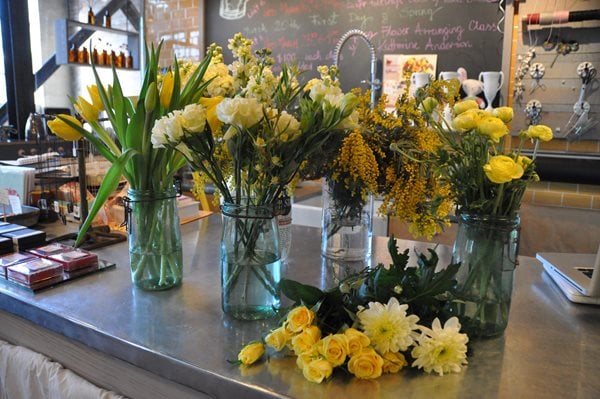
This past week I needed to make an arrangement for a woman who was spending a long day in the hospital with her mom. Fragrant yellow flowers seemed like just the right thing.
I gathered tulips, stock, acacia, ranunculus, leucadendron, roses, and daffodils. I also included some ordinary mums, in pale yellow, and the more exotic wildcat orchid.
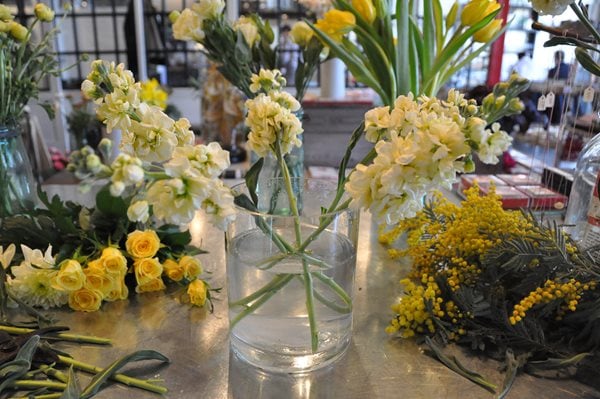
To begin, start with a 7” round vase and clean cool water. Add flower food, if you’ve got it.
Once you’ve stripped the leaves and thorns off the bottom two-thirds of your stems and re-cut the flowers at an angle (use a knife, instead of scissors), begin to layer the sturdier flowers in a circle around the vase, criss-crossing the stems as you go.

I started with the heady stock, then added the sweetly aromatic acacia, using five to seven stems of each, and also reserving a few stems to use in the center of the arrangement.
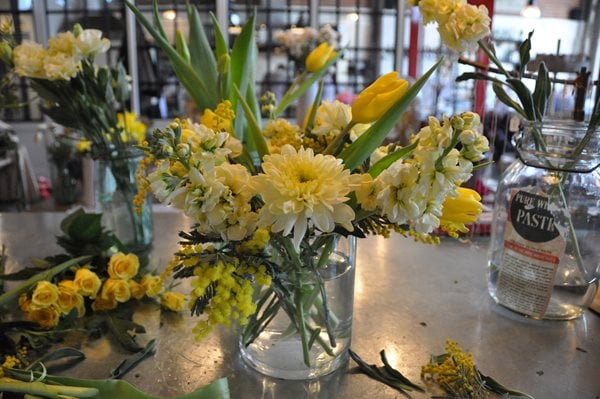
I continue to add the other flowers, (here, the tulips and the mums), playing with the height and composition.

The last flowers to go in the vase should be the ones with the most fragile stems and blooms. In this arrangement, the ranunculus go in last, which I like to see dancing above the other flowers a bit anyway.

With all these flowers in the shop I decided to make a hand-tied yellow bouquet as well.
The real secret with making this type of arrangement is to keep turning the flowers in your hand as you go, creating a spiral with the stems.
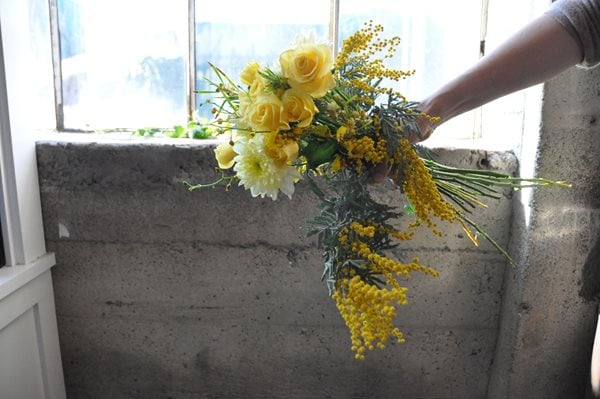
I started with some small yellow roses, crossing the stems in my hand while clasping them fairly close to the underside of the flowers.
In a similar manner to arranging the flowers in a vase, start to layer in other types of flowers around the outside and in between the roses.
As you go, you might find that you want to insert a particular flower into the center of the bouquet to enhance the composition. Do this carefully by loosening your grip and feeding in the flowers from the top.
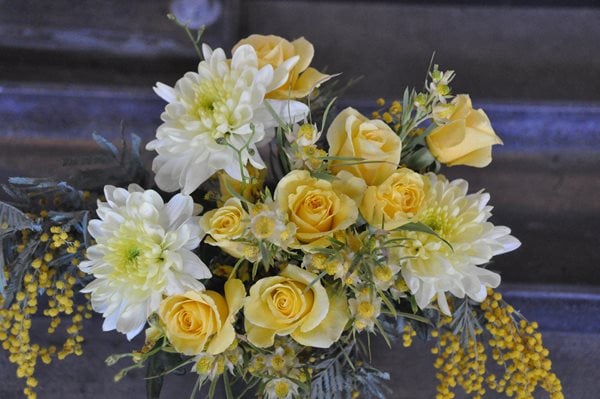
Once the bouquet looks just the way you want, cut the stems to an equal length, and tie up the bouquet with twine (I like to use colored waxed twine) or bundle it together with a rubber band. You can also wrap it tight with green floral tape, which is what I do when I am making bridal bouquets.
A hand-tied bouquet is so pretty as is and can be given as a gift just like this, or wrapped in paper. Alternately, plop it in a tall vase, adjusting the stem length with pruners if needed.

Of course, one or two types of yellow flowers is all you need for your kitchen table, such as these ranunculus in a vintage French glass jar.
In the shop, we are always sticking flower scraps in juice glasses for simple mini-arrangements.

There will be different yellow flowers at different times of the year, from golden-yellow witch hazel in late winter to translucent yellow dahlias in the fall. On the farm, I cultivate yellow flowers so that there will be yellow throughout the seasons and in varying shades of yellow—including hyacinths, chamomile, African marigolds, and of course, sunflowers (I am especially fond of the variety ‘Angel’s Halo’).
At the farm, I am ready to starting tilling the fields in preparation for planting annuals this spring. My pile of seeds includes countless yellows that I’ve grown before or that I want to try for the first time, including old-fashioned pansies and unexpected yellow sweet peas.
My perennial beds are stocked with yellow too, including primroses and yarrow. This year, I would like to plant a row of yellow peonies in the fall. Last year, I even found a pale butter shade of yellow zinnia that I just love.




